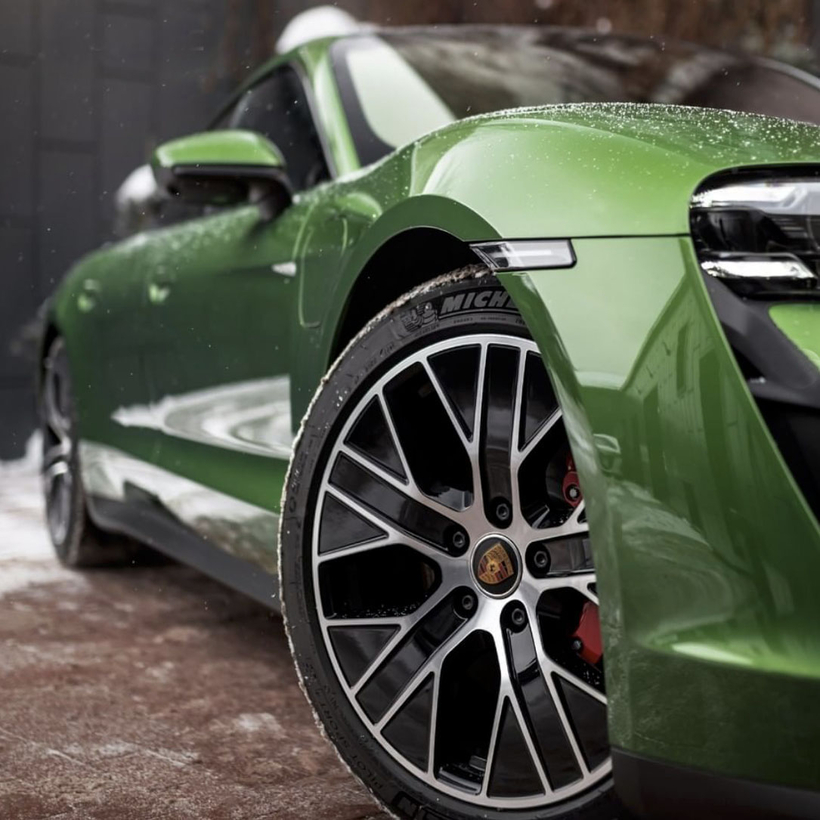As the soot and particulate matter begin to settle, we can see that among the few consequential defeats Donald Trump suffered during his four-year, regulatory guerrilla war on the environment was this whopper: utter failure to kill electric cars.
Surprising even the most pessimistic observers of the auto industry (myself, for instance), car-makers haven’t fallen off the E.V. bandwagon despite the outgoing administration’s best efforts to discourage the rise of these newfangled machines that don’t run on gasoline.
To the contrary, electrified cars—gasoline-electric hybrids and pure battery electric—are being rolled out at an ever accelerating clip, with new models launched most every month, and more than we can count set to debut over the next few years. Indeed, it may not be too long before you’re driving an E.V. yourself. And, if we may hazard a guess after finally spending a week with the new Porsche Taycan 4S, loving it.

Before we come to its considerable technical majesty, let us note up front for those terminally shallow types like me that the Taycan is the best-looking Porsche with four doors and a real back seat—ever. Not for us the bulbous Cayenne S.U.V., which has paid so much of the Volkswagen subsidiary’s rent this century. (The smaller Macan S.U.V. is better looking, to be fair.) Nor would we choose the gasoline-fired Panamera sports sedan, even if we could afford one. It tries harder in the looks department and certainly goes well. But it still manages to appear rotund for its curb weight of 4,500 pounds.
The Taycan is in fact a bit heavier—batteries aren’t light things—but it looks and feels more svelte, with a lower center of gravity that makes cornering even more flat and assured. A low-slung sedan with trunks front and rear, the Taycan is not only lower than the Panamera but more handsome and meaner looking, too. Modern yet classical, with strong notes of its familial ancestry and, to these proletarian eyes, hardly obnoxious at all, even when finished in iris-melting Mamba Green, and rolling on golden rims, as our test car was.
Not Horsing Around
Round-tripping to Long Island’s East End from New York City, it drew an abundance of admiring glances and remarks, especially when we glided silently to top up the batteries at a fast charger on Sag Harbor’s genteel Long Wharf and found ourselves mobbed by the well-heeled citizenry. The ChargePoint charging location here was certainly picturesque, but expensive too, at 40 bucks for about 180 miles of additional range, though still cheaper than gasoline and with no nasty pumps to navigate, an overall win.

Lest there be any confusion, among Taycans the 4S was the poverty spec model. At least it was until last month, when Porsche announced an even cheaper rear-drive-only Taycan (no S) that gets the bidding started at a mere $79,900 (not including delivery charges but before a $7,500 electric-vehicle tax credit). Still, with a comparatively humble list price of $103,800—more than many Teslas—the Taycan 4S is still dramatically less pricey than most Porsches, including the 522-horsepower 4S’s even racier electric stable-mates: the $150,900, 670-horsepower Turbo and the $185,000, 750-horsepower Turbo S.
These are outputs that not long ago would have vanquished Formula 1 fields, but today they are mere ordinary insanity, ever more common in the world of high-end E.V.’s, if rather pointless. They have no relation to anything you might do on a public road in real life except accelerate even harder, while inevitably limiting range.
And though electric cars can’t actually be turbocharged (turbochargers being fed by exhaust gases, of which there are none in an E.V.), in Porscheland, 911 Turbos have long been the ne plus ultra, so why mess with the winning nomenclature?
Literary license aside, this non-“turbo” Taycan S is so fast—zero to 60 in 3.8 seconds, and a top speed of 155 miles per hour—that I’m going to go out on a heretical limb and say it’s fast enough. Its performance numbers shame the Ferraris and Aston Martins that speed demons worshipped scant years ago.

Even in the 4S—like its betters, blessed with two motors, one to power each front and rear axle, for true four-wheel-drive—the experience of hard acceleration is akin to what it would probably feel like being strapped to the landing gear of an F-18 fighter jet as it takes off, only with no significant noise from its motors, just an eerie synthesized audio track to remind you that you’re about to break the speed of sound.
Pressed back into my seat and truly just this side of fainting or hurling from the propulsive force, I found the 4S reminiscent of one of the popular greaser pastimes I’d read about as a boy—the one where the driver proposes a friendly wager, tapes a $20 bill to the windscreen, and dares his passenger to retrieve it if he or she can, while the driver executes the smoky burnout of musclehead lore.
Literary license aside, this non-“turbo” Taycan S is so fast—zero to 60 in 3.8 seconds, and a top speed of 155 miles per hour—that I’m going to go out on a heretical limb and say it’s fast enough.
Child’s play, folks, compared with today’s electric-car experience. I’m all for the defense of a more-than-adequate accelerative offense, but at a certain level it becomes pointless. And that level is the one you bump into right after you’ve decided to ditch the 4S Taycan for the Turbo or Turbo S, with which the 4S shares all its basics—same chassis, steering, air suspension, and unique-to-the-industry two-speed transmission—while weighing up to 200 pounds less.

The 4S list price slaughters the un-optioned Turbo S for thrift, but I say that like it’s a good thing when, for many Porschephiles, it’s not. Indeed, it’s long been de rigueur with the marque that options will hastily leave list prices receding in memory’s rearview mirror, with this tester sporting fully $39,890 of extras, including performance ($6,430) and premium ($7,170) packages, the former with rear-axle steering and torque vectoring, plus an additional $9,880 worth of fancy brakes with ceramic-composite discs and beefier calipers. They’re stupendous, to be sure, but the regular ones won’t be too shabby. Meanwhile, in keeping with Porsche’s leave-no-profit-opportunity-behind tradition, even a rear middle seat is extra as a $480 option for four-plus-one—think little child—capacity.
Like other electric cars that aren’t Teslas—and are thus unable to access Elon Musk’s nationwide network of high-speed charging stations—charging while out on the road may be the greatest obstacle to ownership. But even that’s changing quickly. Parent Volkswagen—partly in settlement of its diesel fraud case of several years back and partly owing to its strategy of going all-in on electric cars—is investing heavily in U.S. charging infrastructure. It’s still not complete, but through its Electrify America partnership, Volkswagen can already claim more than 470 charging stations with more than 2,000 D.C. fast chargers installed, and a cross-country route that allows E.V.’s to make it from Washington, D.C., to L.A. So the future for electric cars is bright, and the so-much-fun Taycan is conspicuous for its excellence in the E.V. category.
And that’s something even Donald Trump couldn’t change.
Jamie Kitman is a car columnist for AIR MAIL


